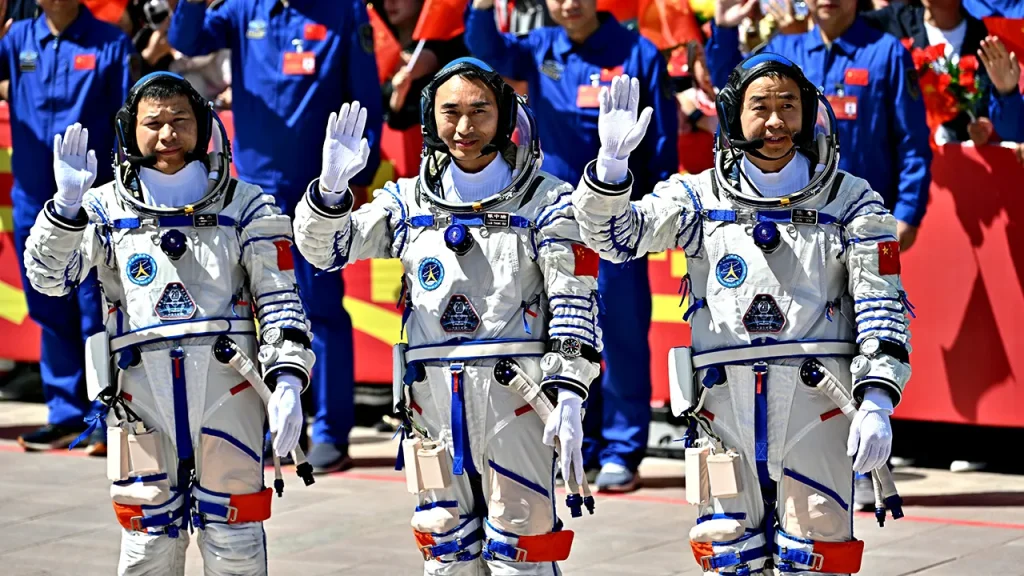Chinese Astronauts Stranded After Space Debris Damages Return Capsule
In a concerning development that highlights the growing dangers of space debris, three Chinese astronauts find themselves unexpectedly stranded aboard the Tiangong space station after their return capsule was apparently struck by tiny fragments of space junk. The Shenzhou-20 crew—mission commander Chen Dong, fighter pilot Chen Zhongrui, and engineer Wang Jie—had been scheduled to return to Earth after completing their six-month mission, but now face an indefinite extension of their stay in orbit as engineers work to assess damage and develop solutions. This incident serves as a stark reminder of the increasingly crowded environment in low Earth orbit, where even the smallest pieces of debris can pose significant hazards to spacecraft and their crews.
The China Manned Space Agency (CMSA) made the announcement Wednesday, explaining that the astronauts’ planned return has been postponed while teams conduct detailed impact analysis and risk assessments on the damaged spacecraft. While specific details about the extent of the damage remain limited, the situation appears serious enough to have prompted consideration of contingency plans. According to established protocols, if the Shenzhou-20 return capsule cannot be repaired, the stranded crew would need to utilize the newly-arrived Shenzhou-21 team’s capsule for their journey back to Earth. This unexpected challenge comes at a pivotal moment, as the Shenzhou-21 crew—consisting of astronauts Zhang Hongzhang, Wu Fei, and Zhang Lu—successfully docked with the station just days ago on Saturday, preparing for what was meant to be a standard crew rotation.
The Shenzhou-20 astronauts launched to Tiangong in April and have spent their time in orbit conducting scientific experiments and performing maintenance tasks, including repairing damage caused by space debris—ironically, the very issue now preventing their scheduled return. The Tiangong space station serves as China’s primary outpost in space, regularly hosting crews of three astronauts on rotating six-month missions as part of the country’s ambitious space program. These missions form a crucial component of China’s growing space capabilities, which have advanced significantly since the nation launched its first crewed spaceflight in 2003. The current predicament, while challenging, demonstrates both the risks inherent to human spaceflight and the necessity for robust contingency planning.
This incident occurs against the backdrop of increasing concerns about space debris, a growing problem that threatens all space operations. As more countries and private companies launch satellites and other spacecraft, the amount of human-made objects in orbit continues to multiply. These range from defunct satellites and spent rocket stages to countless smaller fragments resulting from collisions and degradation of larger objects. Even tiny pieces of debris, traveling at orbital velocities of approximately 17,500 miles per hour, can cause significant damage upon impact—as evidenced by the current situation facing the Chinese crew. Space agencies worldwide have been developing tracking systems and mitigation strategies to address this challenge, but incidents like this underscore the difficulty of fully protecting spacecraft in this increasingly cluttered environment.
China’s response to this emergency situation reflects the country’s maturing capabilities in human spaceflight and crisis management. The nation’s space program has shown remarkable progress over the past two decades, evolving from its first crewed mission to constructing and maintaining its own space station—achievements that place China among a select few spacefaring nations with such capabilities. The current situation, while unwelcome, provides an opportunity for Chinese space engineers and mission controllers to demonstrate their ability to handle unexpected challenges in the harsh environment of space. Their decisions in the coming days will be closely watched by the international space community, as the solutions they develop may inform future approaches to similar emergencies faced by other space programs.
Looking beyond this immediate crisis, China continues to pursue ambitious goals in space exploration, including plans to land astronauts on the lunar surface by 2030. This objective places China in direct competition with the United States, which is working toward its own return to the Moon through the Artemis program. While the current situation with the stranded Shenzhou-20 crew presents a significant challenge, it is unlikely to derail China’s broader space aspirations. Instead, the experience gained from resolving this emergency will likely contribute to the program’s resilience and inform future mission planning and spacecraft design. As both countries race to achieve their lunar ambitions, incidents like this serve as sobering reminders of the inherent dangers and technical challenges that come with human spaceflight—challenges that require continuous innovation, rigorous safety protocols, and international cooperation to overcome.


